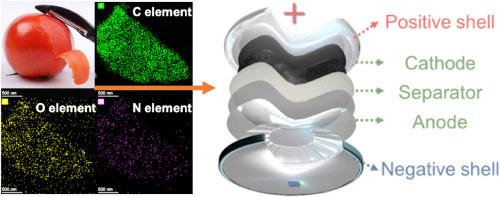生物质衍生的N/O共掺杂中微孔碳纳米片用于高性能锌储存
IF 4.7
3区 材料科学
Q1 CHEMISTRY, APPLIED
引用次数: 0
摘要
生物质基多孔碳电极材料技术的发展对构建可持续发展的碳基能源材料体系具有重要意义。本研究提出了一种以番茄皮为碳源的氮/氧共掺杂中微孔碳纳米片,通过简单的KOH活化策略。TEM、XRD、Raman、XPS等一系列表征结果表明,制备的多孔碳具有发达的分层孔结构(比表面积2976.4 m2 g−1,孔体积1.63 cm3 g−1),石墨化微晶丰富,N、O杂原子共掺杂,亲水性良好。在0.1 a g−1电流密度下,以多孔碳为阴极,2 mol L−1 ZnSO4水溶液为电解质,锌箔为阳极组装的纽扣型锌离子杂化电容器(ZIHSC)的比容量为181.2 mAh g−1。当电流密度放大500倍至50 A g−1时,比容量仍保持79.9 mAh g−1,具有优异的倍率性能。最大能量密度可达144.5 Wh kg−1,最大功率密度可达40.7 kW kg−1。本研究为高价值利用低价值生物质废弃物制备电极材料提供了技术支持。本文章由计算机程序翻译,如有差异,请以英文原文为准。

Biomass-derived N/O co-doped meso-microporous carbon nanosheets for high performance zinc storage
The development of biomass-based porous carbon electrode material technology is of crucial significance to construct a sustainable carbon based energy material system. This work presents an N/O co-doped meso-microporous carbon nanosheets with tomato peel as a carbon source via a facile KOH activation strategy. A series of characterization results, such as TEM, XRD, Raman, XPS, etc., show that the resultant porous carbon possesses a developed hierarchical pore structure (specific surface area and pore volume of 2976.4 m2 g−1 and 1.63 cm3 g−1, respectively), abundant graphitized microcrystals, co-doping of N and O heteroatoms and good hydrophilicity. The button-type zinc ion hybrid capacitor (ZIHSC) assembled by as-prepared porous carbon as the cathode, 2 mol L−1 ZnSO4 aqueous solution as the electrolyte and Zn foil as the anode exhibits a specific capacity of 181.2 mAh g−1 at a current density of 0.1 A g−1. When the current density is amplified by 500 times to 50 A g−1, the specific capacity still maintains 79.9 mAh g−1, demonstrating excellent rate performance. The maximum energy density and power density are up to 144.5 Wh kg−1 and 40.7 kW kg−1, respectively. This study provides technical support for the high-value utilization of low value biomass waste to prepare electrode materials.
求助全文
通过发布文献求助,成功后即可免费获取论文全文。
去求助
来源期刊

Microporous and Mesoporous Materials
化学-材料科学:综合
CiteScore
10.70
自引率
5.80%
发文量
649
审稿时长
26 days
期刊介绍:
Microporous and Mesoporous Materials covers novel and significant aspects of porous solids classified as either microporous (pore size up to 2 nm) or mesoporous (pore size 2 to 50 nm). The porosity should have a specific impact on the material properties or application. Typical examples are zeolites and zeolite-like materials, pillared materials, clathrasils and clathrates, carbon molecular sieves, ordered mesoporous materials, organic/inorganic porous hybrid materials, or porous metal oxides. Both natural and synthetic porous materials are within the scope of the journal.
Topics which are particularly of interest include:
All aspects of natural microporous and mesoporous solids
The synthesis of crystalline or amorphous porous materials
The physico-chemical characterization of microporous and mesoporous solids, especially spectroscopic and microscopic
The modification of microporous and mesoporous solids, for example by ion exchange or solid-state reactions
All topics related to diffusion of mobile species in the pores of microporous and mesoporous materials
Adsorption (and other separation techniques) using microporous or mesoporous adsorbents
Catalysis by microporous and mesoporous materials
Host/guest interactions
Theoretical chemistry and modelling of host/guest interactions
All topics related to the application of microporous and mesoporous materials in industrial catalysis, separation technology, environmental protection, electrochemistry, membranes, sensors, optical devices, etc.
 求助内容:
求助内容: 应助结果提醒方式:
应助结果提醒方式:


